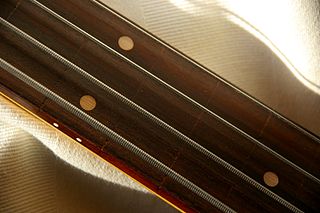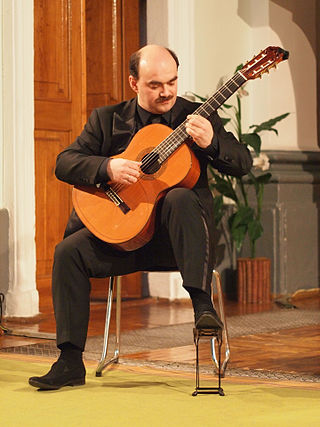Related Research Articles

The classical guitar, also known as Spanish guitar, is a member of the guitar family used in classical music and other styles. An acoustic wooden string instrument with strings made of gut or nylon, it is a precursor of the modern steel-string acoustic and electric guitars, both of which use metal strings. Classical guitars derive from instruments such as the lute, the vihuela, the gittern, which evolved into the Renaissance guitar and into the 17th and 18th-century baroque guitar. Today's modern classical guitar was established by the late designs of the 19th-century Spanish luthier, Antonio Torres Jurado.

A guitarist is a person who plays the guitar. Guitarists may play a variety of guitar family instruments such as classical guitars, acoustic guitars, electric guitars, and bass guitars. Some guitarists accompany themselves on the guitar by singing or playing the harmonica, or both.

Nylon is a family of synthetic polymers with amide backbones, usually linking aliphatic or semi-aromatic groups.

Andrés Segovia Torres, 1st Marquis of Salobreña, was a Spanish virtuoso classical guitarist. Many professional classical guitarists were either students of Segovia or students of Segovia's students. Segovia's contribution to the modern-romantic repertoire included not only commissions but also his own transcriptions of classical or baroque works. He is remembered for his expressive performances: his wide palette of tone, and his distinctive musical personality, phrasing and style.

A guitar pick is a plectrum used for guitars. Picks are generally made of one uniform material, such as some kind of plastic, rubber, felt, tortoiseshell, wood, metal, glass, tagua, thermosetting plastic or stone. They are often shaped in an acute isosceles triangle with the two equal corners rounded and the third corner less rounded. They are used to strum chords or to sound individual notes on a guitar.

The seven-string guitar adds one additional string to the more common six-string guitar, commonly used to extend the bass range or also to extend the treble range.

Fingerstyle guitar is the technique of playing the guitar or bass guitar by plucking the strings directly with the fingertips, fingernails, or picks attached to fingers, as opposed to flatpicking. The term "fingerstyle" is something of a misnomer, since it is present in several different genres and styles of music—but mostly, because it involves a completely different technique, not just a "style" of playing, especially for the guitarist's picking/plucking hand. The term is often used synonymously with fingerpicking except in classical guitar circles, although fingerpicking can also refer to a specific tradition of folk, blues and country guitar playing in the US. The terms "fingerstyle" and "fingerpicking" are also applied to similar string instruments such as the banjo.
D'Addario is a family-owned and operated American multinational company that specializes in musical instrument accessories, headquartered in Farmingdale, Long Island, New York.

The Russian guitar (sometimes referred to as a "Gypsy guitar") is an acoustic seven-string guitar that was developed in Russia toward the end of the 18th century: it shares most of its organological features with the Spanish guitar, although some historians insist on English guitar descent. It is known in Russian as the semistrunnaya gitara (семиструнная гитара), or affectionately as the semistrunka (семиструнка), which translates to "seven-stringer". These guitars are most commonly tuned to an open G chord as follows: D2 G2 B2 D3 G3 B3 D4. In classical literature, the lowest string (D) occasionally is tuned down to the C.

In music, strings are long flexible structures on string instruments that produce sound through vibration. Strings are held under tension so that they can vibrate freely. The pitch (frequency) at which a string will vibrate is primarily related to its vibrating length, its tension, and its mass per unit of length. A vibrating string produces very little sound by itself. Therefore, most string instruments have a soundboard to amplify the sound.

Angelo Gilardino was an Italian composer, guitarist, and musicologist.
Stephen Paul is an American classical guitarist best known by the stage name Esteban. He is from the Pittsburgh area and has lived in Tempe, Arizona since 1976.

Ramírez Guitars is a Spanish manufacturer of professional, concert-quality classical and flamenco guitars. Five generations of the Ramírez family have produced Ramirez guitars.

In classical guitar, the right hand is developed in such a way that it can sustain two, three, and four voice harmonies while also paying special attention to tone production. The index (i), middle (m), and ring (a) fingers are generally used to play the melody, while the thumb (p) accompanies in the bass register adding harmony and produces a comparable texture and effect to that of the piano. The classical guitar is a solo polyphonic instrument.

A flamenco guitar is a guitar similar to a classical guitar, but with lower action, thinner tops and less internal bracing. It usually has nylon strings, like the classical guitar, but it generally possesses a livelier, more gritty sound compared to the classical guitar. It is used in toque, the guitar-playing part of the art of flamenco.
A person who is specialized in the making of stringed instruments such as guitars, lutes and violins is called a luthier.
Classical guitar strings are strings manufactured for use on classical guitars. While steel-string acoustic guitar strings and electric guitar strings are made of metal, modern classical guitar strings are made of nylon and nylon wound with wire, which produces a different sound to the metal strings. Classical guitar strings were originally made with animal intestine and silk wound with animal intestine up until World War II, when war restrictions led Albert Augustine Ltd. to develop nylon strings. Nylon guitar strings were put into production in 1948. Strings made from fluorocarbon polymers have since been developed and are the main alternative to nylon strings.

Vladimir Bobri, born Volodymyr Bobritskiy was an illustrator, writer, composer, educator, and guitar historian. Celebrated for his prolific and innovative graphic design work in New York since the mid-1920s, Bobri was also a founder of the New York Society of The Classic Guitar in 1936, and served as editor and art director of its magazine, Guitar Review, for nearly 40 years.
Classical electric guitars, also known as nylon-string electric guitars, represent a unique fusion of traditional classical guitar design and modern electric guitar technology. These instruments combine the rich and warm tonal qualities of nylon-stringed classical guitars with the versatility and amplified sound capabilities of electric guitars. By integrating nylon strings with onboard electronics, pickups, and preamp systems, classical electric guitars offer musicians a wide range of sonic possibilities for various musical genres and performance settings.

The ten string extended-range classical guitar, with fully chromatic, sympathetic string resonance was conceived in 1963 by Narciso Yepes, and constructed by José Ramírez [III]. This instrument is sometimes referred to as the "modern" 10-string guitar to differentiate it from ten-stringed harp guitars of the 19th century.
References
- 1 2 "For a Rare Discarded Harp, a Chance to Sing Again ", Colin Moynihan, The New York Times , August 10, 2009
- 1 2 3 4 5 6 7 "From Gut to Nylon Archived 2009-08-03 at the Wayback Machine ", Ivor Mairants, 1980
- ↑ Bellow, Alexander (1970). The Illustrated History of the Guitar. New York: Belwin-Mills. p. 193.
- ↑ McLellan, Dennis (2003-05-02). "Rose Augustine, 93; Firm Developed Nylon Strings for the Classical Guitar". Los Angeles Times. p. B.17. Archived from the original on October 22, 2012.
- ↑ "For the Good of All Guitarists". augustinestrings.com. Retrieved 2025-01-27.